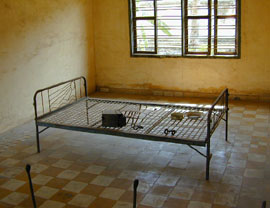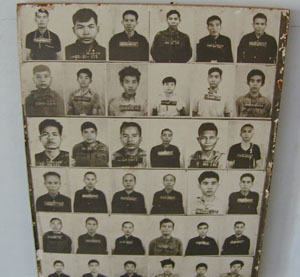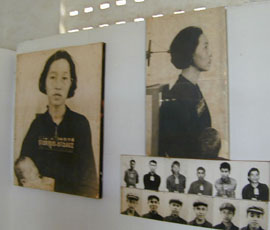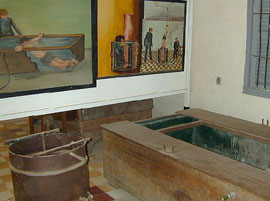Museum Tour: The Tuol Sleng Genocide Museum
The Cambodia Series > Stung > Gun Range > Pyongyang > Tuol Sleng > Sapors
It is estimated that during the Cambodian Genocide (1975-1979) 1.7 million people lost their lives at the hands of the Khmer Rouge. During that time, radical left wing politics mixed with a complete lack of regard for human life to create one of the most vicious and despicable reigns of terror in the history of man.
 Teachers, professors, farmers, engineers, students and skilled artisans were murdered. Entire populations of cities were either starved or forced out from their homes into collective farms.
Teachers, professors, farmers, engineers, students and skilled artisans were murdered. Entire populations of cities were either starved or forced out from their homes into collective farms.
Some that were deemed to be in opposition, or considered as posing a potential threat, to the Khmer Rouge Government (or Angkar) were brought to Tuol Sleng (also known as S-21, or "Security Office 21"), a former high school converted to a prison, in Phnom Penh. Here, amid what can only be described as pure madness - 14,000 prisoners were interrogated, tortured, beaten, and "exterminated."
Over the years since, the crimes of the Khmer Rouge during the Cambodian Genocide went mostly undocumented. Today, Tuol Sleng is a museum dedicated to those that might have otherwise been forgotten.
For prisoners at Tuol Sleng, a typical day consisted of nothing short of sheer horror and the strict adherence to ten rules...
1. You must answer accordingly to my questions. Do not turn them away.
There are four main buildings (A, B, C, and D) set in approximately a horseshoe shape around an open central yard of grass and trees. Only the first floors of all the buildings are open for viewing.
A large iron fence, topped with barbed wire, surrounds the entire 600 m x 400 m compound. Landmine victims ask for change at the gated entrance off Street 113, bordering the property.
 2. Do not try to hide the facts by making pretexts of this and that. You are strictly prohibited to contest me.
2. Do not try to hide the facts by making pretexts of this and that. You are strictly prohibited to contest me.
The first floor of Building A has ten open cells (formerly classrooms) extending down a hallway that runs at the edge of the greenery. In the hallway, the walls are a washed mix of deteriorating white and gray concrete.
3. Do not be a fool for you are a chap who dares to thwart the revolution.
In each room, five three-foot iron bars, used for shackling prisoners, extend vertically from the alternating yellow and red tile floor near the entrance. Their ends are hooked at the top. The entrance door is wood and the windows have iron bars running horizontally and vertically. A single bed frame sits in the middle of the room. Various clamps and other steel implements, used in the torture and shackling procedure, rest on the bed. A large black and white photo displaying the torture of a prisoner hangs on the wall. A rusted US Army ammo box sits next to the implements, apparently used for their storage.
4. You must immediately answer my questions without wasting time to reflect.
Building B sits next to Building A and forms a right angle in the coutyard. At this junction there is a large wooden structure sits at the edge of the grass. It is composed of two vertical columns and one horizontal beam. The beam hangs roughly ten feet off the ground. Three eyelets, separated proportionately, hang down from the beam. A large cracked clay pot sits at its edge.
 As depicted in a painting by Tuol Sleng survivor (one of the few) Vann Nath, selected prisoners were hoisted up through the eyelets with rope, turned upside down, and dunked headfirst into the clay pot - at the time filled with water - as a means of interrogation.
As depicted in a painting by Tuol Sleng survivor (one of the few) Vann Nath, selected prisoners were hoisted up through the eyelets with rope, turned upside down, and dunked headfirst into the clay pot - at the time filled with water - as a means of interrogation.
5. Do not tell me either about your immoralities or the revolution.
Building B houses a series of rooms. The majority of which feature photos of some of the prisoners: Cambodians, Vietnamese, Thais, Laotians, New Zealanders, Americans, men, women, and children. They are mostly front and side view mug shots. They are numbered and dated. Some necks have chains around them. Some hands look to be tucked behind backs. Some women hold babies. Some men and boys wear berets. All look very sad.
6. While getting lashes or electrification you must not cry at all.
Number 108 is a man with protruding eyes. Number 408 is a scared young girl. Number 275 is a gray-haired old woman. Number 189 is a man who is missing one of his arms. Number 66 is a man exhibiting a strong jaw but a very emaciated upper body. Numbers 12 and 17 are young boys.
7. Do nothing. Sit still and wait for my orders. If there is no order, keep quiet. When I ask you to do nothing. You must do it right away without protesting.
 In the last room, shackling irons sit behind a glass case. Photos of the disposal areas for the bodies hang on the walls. In them, skulls line up in a field like melons at a market. Bones fill burial pits like kindling before the lighting of a fire. A concrete bust of Pol Pot sits chained to the floor. It was sculpted by one of the prisoners.
In the last room, shackling irons sit behind a glass case. Photos of the disposal areas for the bodies hang on the walls. In them, skulls line up in a field like melons at a market. Bones fill burial pits like kindling before the lighting of a fire. A concrete bust of Pol Pot sits chained to the floor. It was sculpted by one of the prisoners.
8. Do not make pretexts about Kampuchea Krom in order to hide your jaw of traitor.
Building C and Building B sit next to each other, end to end. An information sign indicates that on the third floor "the braid of barbed wires prevents the desperate victims from committing suicide."
A labyrinth of brick walls forms makeshift cells all along the bottom floor. Chains are attached to the individual cell floors. The horizontal dimensions of the cells are perhaps twice as big the inside of a chimney.
9. If you do not follow all the above rules, you shall get many lashes of electric wire.
Building D forms a right angle with Building C to complete the horseshoe shape around the courtyard. Inside are actual torture devices. More paintings by Vann Nath hang above many devices to give a visual description of their grisly use.
 Some procedures involved: shackling a prisoner facedown in a coffin-like container filled to the brim with water, suspending a prisoner from the ceiling with rope and dunking him headfirst into a barrel of water, and pinning a prisoner to the floor while chemicals are poured over one of his immobilized hands gripped in a wrench.
Some procedures involved: shackling a prisoner facedown in a coffin-like container filled to the brim with water, suspending a prisoner from the ceiling with rope and dunking him headfirst into a barrel of water, and pinning a prisoner to the floor while chemicals are poured over one of his immobilized hands gripped in a wrench.
10. If you disobey any point of my regulations you shall get either ten lashes or five shocks of electric discharge.
In the final room, skulls of former prisoners form a chalkboard-sized map of Cambodia. It is mounted on the wall and is the prominent feature of the room, and perhaps all of Tuol Sleng itself. The Mekong River flows in red between the skulls through the length of the country.
Note: Tuol Sleng Genocide Museum is located at Street 113, Boeng Keng Kang 3, Chamkar Morn, Phnom Penh. Admission is $3.
The Documentation Center of Cambodia is now printing their magazines in English.
The Cambodia Series > Stung > Gun Range > Pyongyang > Sapors

